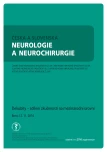Sorrorigens Wounds, Their Identification and Treatment Process
Authors:
A. Pokorná 1; S. Saibertová 1; R. Velichová 2; S.vasmanská 1
Authors‘ workplace:
Katedra ošetřovatelství, LF MU, Brno
1; Institut biostatistiky a analýz, LF MU, Brno
2
Published in:
Cesk Slov Neurol N 2016; 79/112(Supplementum1): 31-36
Category:
Original Paper
doi:
https://doi.org/10.14735/amcsnn2016S31
Overview
Aim:
The aim of this study was to analyse the incidence of iatrogenic and sor rorigenic wounds in patients hospitalised at intensive care units.
Material and methods:
A 4-month multicentric observational descriptive study. Statistical analyses were performed us ing IBM SPSS Statistics for Windows, Version 22.0.0.1. In total, eight units in six diff erent university and regional hospitals in South Moravia and Vysocina regions were involved (six anaesthesiology and resuscitation units and two intensive care units). The study involved all patients hospitalised dur ing a four-month period at the participat ing units.
Results:
A sor rorigenic wound was identified in 129 of 767 hospitalized patients (46.5% female and 53.5% male). The mean age of patients was 64.1 years (SD 15.5). In total, 169 wounds were observed, the majority of which occured dur ing hospitalisation at a participating unit (62.1%) and were identified by nurses (98.8%). The majority of patients had just one wound (78.3%). Pres sure sores were the most frequent (34.9%), fol lowed by excoriations (23.1%) and incontinence-as sociated dermatitis (12.4%). Extensive bruis ing (3.0%) and burns (1.8%) were the least frequent. The wounds were documented (96.4%), includ ing photography (79.3%) but only in 30.8% as an adverse event.
Conclusion:
Iatrogenic and sor rorigenic wounds increase cost of care, prolong hospitalisation even though they are mostly preventable. We verified statistical diff erences in preventive strategies before and after a wound dia gnosis (p = 0.012) as well as associations between the main cause of a wound and its type (p < 0.05; except the inappropriate intervention category). We confi rmed the importance of preventive actions.
Key words:
iatrogenic – sorrorigenic – wound – intensive care – nursing – prevention
The authors declare they have no potential conflicts of interest concerning drugs, products, or services used in the study.
The Editorial Board declares that the manuscript met the ICMJE “uniform requirements” for biomedical papers.
Sources
1. Lee TG, Chung S, Chung YK. A retrospective review of iatrogenic skin and soft tissue injuries. Arch Plast Surg 2012;39(4):412 – 6. doi: 10.5999/ aps.2012.39.4.412.
2. Koutná M, Pokorná A, Ulrych O. Hojení ran v intenzivní péči I. Hojení Ran 2012;6(3):22 – 7.
3. Koutná M., Pokorná A. Hojení ran v intenzivní péči IV. Hojení Ran 2013;7(1):3 – 10.
4. Mareš J, Pečenková J, Spoustová V. Iatropatogenie a sororigenie aneb jak lze poškozovat člověka. 2. vyd. Praha: Vysoká škola J. A. Komenského 2002.
5. Compromised Wounds in Canada. Canadian Institute for Health information and Statistic 2013. [online]. Available z URL: https:/ / secure.cihi.ca/ free_products/ AiB_Compromised_Wounds_EN.pdf 6.
6. Cheng CE, Kroshinsky D. Iatrogenic skin injury in hospitalized patients. Clin Dermatol 2011;29(6):622 – 32. doi: 10.1016/ j.clindermatol.2011.08.006.
7. Moreo K. Understanding and overcoming the challenges of effective case management for patients with chronic wounds. Case Manager 2005;16(2):62 – 3,67. doi: 10.1016/ j.casemgr.2005.01.014.
8. Augustin M, Maier K. Psychosomatic Aspects of Chronic Wounds. Dermatol Psychosom 2003;4 : 5 – 13. doi: 10.1159/ 000070529.
9. Black JM, Edsberg LE, Baharestani MM, et al. Pressure ulcers: avoidable or unavoidable? Results of the National Pressure Ulcer Advisory Panel Consensus Conference. Ostomy Wound Manag 2011;57(2):24 – 37.
10. Edsberg LE, Langemo D, Baharestani MM, et al. Unavoidable pressure injury: state of the science and consensus outcomes. J Wound Ostomy Continence Nurs 2014;41(4):313 – 34. doi: 10.1097/ WON.0000000000000050.
11. Nanjo Y, Nakagami G, Kaitani T, et al. Relationship between morphological characteristicsand etiology of pressure ulcers in intensive care unit patients. J Wound Ostomy Continence Nurs 2011;38(4):404 – 12. doi: 10.1097/ WON.0b013e318220b6bc.
12. Brienza D, Antokal S, Herbe L, et al. A.Friction-induced skin injuries-are they pressure ulcers? An updated NPUAP white paper. J Wound Ostomy Continence Nurs 2015;42(1):62 – 4. doi: 10.1097/ WON.0000000000000102.
13. Beeckman D, Campbell J, Campbell K. et al. Proceedings of the Global IAD Expert Panel. Incontinence associated dermatitis: moving prevention forward. [online]. Available from URL: www.woundsinternational.com.
14. Krajčíková N, Pokorná A. Problematika dermatitidy při inkontinenci moči a/ nebo stolice. Česká Dermatovenerologie 2016;6(1):57 – 60.
Labels
Paediatric neurology Neurosurgery NeurologyArticle was published in
Czech and Slovak Neurology and Neurosurgery

2016 Issue Supplementum1
- Advances in the Treatment of Myasthenia Gravis on the Horizon
- Metamizole at a Glance and in Practice – Effective Non-Opioid Analgesic for All Ages
- Memantine in Dementia Therapy – Current Findings and Possible Future Applications
Most read in this issue
- Sorrorigens Wounds, Their Identification and Treatment Process
- Incontinence-associated Dermatitis – Current Knowledge on Etiology, Diagnosis and Prevention
- The Importance and Limits of the Pressure Ulcer Surgical Debridement
- The Relevance of Pressure Mapping System in Wheelchair Mobility
